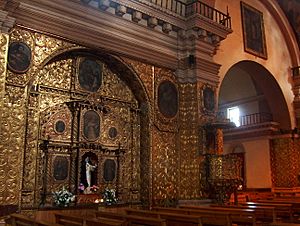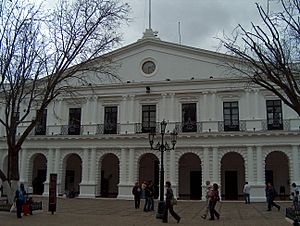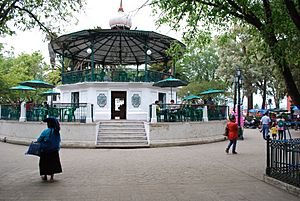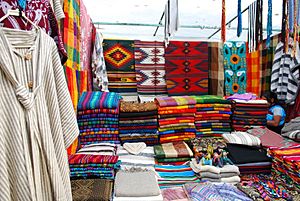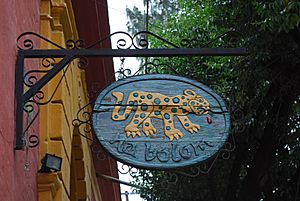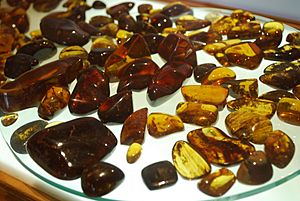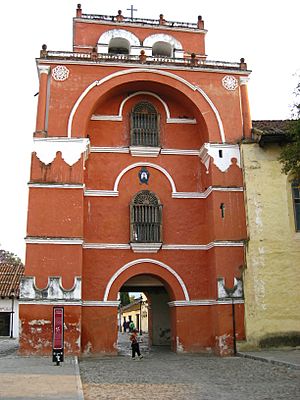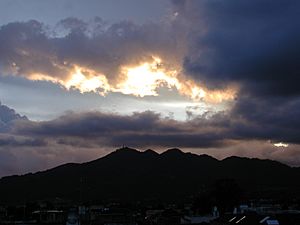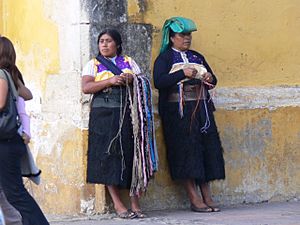San Cristóbal de las Casas facts for kids
Quick facts for kids
San Cristóbal de las Casas
|
||
|---|---|---|
|
City and municipality
|
||
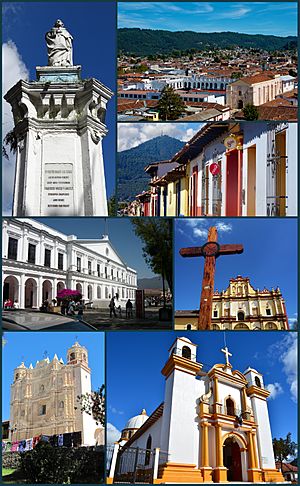
Above, from left to right: Statue of Bartolome de las Casas, Aerial view of San Cristóbal de las Casas, Historical center, City Hall of San Cristobal de las Casas, Cathedral of San Cristóbal de las Casas, Temple and former convent of Santo Domingo, Church of Our Lady of Guadalupe
|
||
|
||
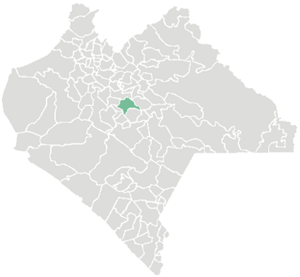 |
||
| Country | ||
| State | Chiapas | |
| Founded | 1528 | |
| Named for | St. Christopher and Bartolomé de las Casas | |
| Area | ||
| • Municipality | 394.2 km2 (152.2 sq mi) | |
| • Seat | 35.6 km2 (13.7 sq mi) | |
| Elevation
(of seat)
|
2,200 m (7,200 ft) | |
| Population
(2020 census)
|
||
| • Municipality | 215,874 | |
| • Seat | 183,509 | |
| • Seat density | 5,155/km2 (13,351/sq mi) | |
| Time zone | UTC-6 (Central (US Central)) | |
| • Summer (DST) | UTC-5 (Central) | |
| Postal code (of seat) |
29200
|
|
San Cristóbal de las Casas (also known as Jovel in the Tzotzil language) is a city and municipality in the Central Highlands of Chiapas, Mexico. It was once the capital of the state until 1892. Today, it is still seen as the cultural heart of Chiapas.
The area is mostly mountainous. However, the city itself sits in a small valley surrounded by hills. The city center looks much like it did in Spanish colonial times. It has red tile roofs, cobblestone streets, and balconies with flowers. The main ways people make money here are through trade, services, and tourism.
Visitors come to San Cristóbal to explore its history, culture, and the traditions of its local people. Famous places include the main cathedral, the Santo Domingo church with its big outdoor craft market, and the Casa Na Bolom museum. The area also has cool natural spots like caves and rivers, even though many trees have been cut down.
Contents
Exploring San Cristóbal: City and Community

San Cristóbal de las Casas is both a city and a municipality. A municipality is like a local government area. The city acts as the main center for 83 smaller communities around it. These communities cover about 484 square kilometers. Important ones include La Candelaria and San Antonio del Monte. The municipality shares borders with other areas like Chamula and Zinacantán.
The city's historic center still looks very old. It has narrow cobblestone streets and red clay tile roofs. Many buildings have wrought iron balconies decorated with flowers. The buildings show different styles, from Baroque to Neoclassical. You might even see milk delivered by donkeys! Farmers also use horses and donkeys to move wood and crops.
San Cristóbal is known as the "cultural capital" of Chiapas. In 2003, it was named a "Pueblo Mágico" (Magical Village). This means it's a special place recognized for its culture and beauty. A big part of its culture comes from the many Tzotzil and Tzeltal people living here. They are famous for making textiles, especially weaving. Amber is another important product. You can also find ceramics and jewelry. The best place to find crafts is the market at Santo Domingo.
The city also hosts an annual Amber Expo. This event shows and sells beautiful amber pieces from the state. There's also a traditional Mexican market near the Santo Tomas Church. It's open every day except Sunday. Here, you can find traditional foods like saffron tamales and a drink called posh.
Many visitors have decided to live in San Cristóbal. This has brought new influences to the city, especially in the historic center. You can find restaurants with Italian, French, and other international foods. The city is also known for its cured meats, a tradition from Spanish and German influences. The nightlife offers different music styles like reggae and salsa.
Fireworks are common during religious festivals. Big celebrations include those for the Dulce Niño de Jesús and San Cristóbal. Holy Week is a very special time with many processions. People march, some in pointed hoods, carrying religious figures. They visit homes with small shrines, saying prayers and giving blessings.
The Feria de la Primavera y la Paz (Spring and Peace Fair) happens during Holy Week. It has music and costumes. It ends with the "Burning of Judas" where figures representing different ideas are lit up. Bullfights are also held during this fair.
The Festival Cervantino Barroco is an annual event. It brings artists from Mexico and other countries. They perform concerts, plays, and hold exhibitions.
Landmarks and Historic Buildings
The main plaza is the heart of the city. It's officially called Plaza 31 de marzo, but most people call it the Zócalo. Long ago, it was the city's main market and water source. Today, it has a kiosk built in the early 1900s. The kiosk has notes about important events in San Cristóbal's history. The plaza is surrounded by gardens and important buildings.
The Cathedral: A City Symbol
The cathedral is north of the main plaza. It is the most famous symbol of the city. It faces its own open area called the Cathedral Plaza. The first church here was built in 1528. When San Cristóbal became a diocese in the 1600s, a new, bigger church was built. It was named after Saint Christopher, the city's patron saint.
The cathedral mixes European Baroque, Moorish, and local styles. Its main front was finished in 1721. It is yellow with fancy columns and statues of saints. Inside, the main altar honors both the Virgin of the Assumption and Saint Christopher. The wooden pulpit is very old and covered in gold. You might see older indigenous women kneeling as they move through the church.
Behind the cathedral is the San Nicolás Temple. It was built between 1613 and 1621 for the local people. It's the only church in the city that hasn't changed much. Its roof is pyramid-shaped, made of wood and tile.
City Hall: Government and Gatherings
The city hall, also called the Palacio de Gobierno, is a Neoclassical building from the 1800s. It has arches supported by columns. In the evenings, young people often walk around the gazebo in front of it. The city hall is sometimes a place for protests. These can be related to groups like the Zapatistas.
Santo Domingo Church: Art and Markets
When Dominican monks came to San Cristóbal, they built their church and monastery. The first stone was laid in 1547. It is one of the most decorated buildings in Latin America. Its front is Baroque, with columns and stucco designs. The inside walls are covered with gold-covered altarpieces.
The La Caridad Temple was built nearby in 1712. It was part of the first hospital for indigenous people. Its design is like an altarpiece with a bell tower. The complex also has two museums. The Museo de la Historia de la Ciudad tells the city's history. The Centro Cultural de los Altos shows textiles from the area's different groups. It also has a shop called Sna-Jolobil, meaning "house of weaving."
Casa Na Bolom: A Home of Exploration
Casa Na Bolom (House of the Jaguar) is a museum, hotel, and restaurant. It was once a seminary built in 1891. Later, it became the home of Frans Blom and Gertrude Duby Blom. Frans was an explorer, and Gertrude was a journalist and photographer. They spent over 50 years in Chiapas. They collected tools, crafts, and clothing, especially from the Lacandon Jungle and its people.
The museum shows their collection and keeps some of their old rooms as they were. It also has a library with over 10,000 books about the region's history and culture. There's also a botanical garden in the back.
La Merced Monastery: From Fortress to Museum
The La Merced monastery was the first in the city, founded in 1537. It was built like a fortress to protect people in case of attack. The church entrance has a huge wooden door. There are few windows, and they were made for muskets.
The church still works today. Its inside was updated in the Neoclassical style. The oldest part is an arch and columns in the sacristy. In the late 1800s, it was a military barracks. In 1960, it became the city jail until 1993. In 2000, it became the Museum of Amber. It has over 300 pieces of amber and is the only museum of its kind in the Americas.
Carmen Temple and Arco Torre: Moorish Style Gems
The Carmen Temple and the Arco Torre are in Moorish style. The Carmen Temple is what's left of the old La Encarnación convent, founded in 1597. The original church burned down but was rebuilt. Its layout is L-shaped, which is unusual.
An arch with a tower, called the Arco del Carmen, was built next to the convent in 1680. It is in a pure Moorish style, unique in Mexico. This arch and tower are now symbols of San Cristóbal.
Other Important Churches and Museums
The San Cristóbal Church is on top of a hill. It offers great views of the city. Its patron saint is celebrated on July 25 with music, food, and fireworks.
The San Francisco Church was built by Franciscans in 1577. The current church is from the 1700s. It has a single main room and six Baroque altarpieces.
The Guadalupe Church is on Cerro de Guadalupe. You climb 79 stairs to reach it. It has a single main room and a side chapel. Its feast day is celebrated yearly with a parade and fireworks.
The Santo Tomas Church is just north of the historic center. It has a museum in the back.
The Santa Lucía Church was built in 1884. It has a single main room with pointed arches. Its main altar mixes Gothic, Neoclassical, and Art Nouveau styles.
The Museo Mesoamericano del Jade has jade pieces from ancient cultures like the Maya and Aztec. It also has a life-sized copy of the burial chamber of Pakal from Palenque. The Maya Medicine Museum shows traditional indigenous medicine. The Museo de las Culturas Populares de Chiapas focuses on the state's indigenous cultures.
Casa de las Sirenas is an old house from the 1500s. It's named for a mermaid on its crest. The Antiguo Colegio de San Francisco Javier now houses the Faculty of Law. It was founded by Jesuits in 1681 to educate the Spanish elite.
San Cristóbal's Journey Through Time
The city was founded in 1528 by Diego de Mazariegos. It has had many names over the years. It was called Villa Real de Chiapa, then Ciudad Real. In 1829, it became Ciudad de San Cristóbal. "de las Casas" was added in 1848 to honor Bartolomé de las Casas. In the local Tzotzil and Tzeltal languages, the area is called Jovel, meaning "the place in the clouds."
Before the Spanish arrived, there was no big city here. After defeating local groups, Diego de Mazariegos started the city as a military fort. In 1532, San Cristóbal became part of the Captaincy General of Guatemala. It received its coat of arms in 1535 and was officially a city in 1536.
In 1821, the city declared independence from Spain. In 1824, it became part of Mexico and was made the state capital. During the 1800s, the state government often moved between San Cristóbal and Tuxtla. This was because San Cristóbal was controlled by Conservatives, and Tuxtla by Liberals. In 1892, the capital moved to Tuxtla for good.
In 1915, San Cristóbal became a municipality. It used to include other communities, but they later became their own municipalities. In the 1900s, open pit mines for gravel and sand appeared around the city. This caused environmental concerns, as it affected water supplies. One mine near the historic center was closed in the 2000s.
The city was declared a national historic monument in 1974.
The Zapatista Movement and Its Impact
San Cristóbal became a center for political activity when Samuel Ruiz became bishop of Chiapas in 1960. He worked with priests and nuns who followed a belief called liberation theology. This idea focused on helping the poor and oppressed. In 1974, he organized a meeting for indigenous people from different groups. This meeting aimed to unite them politically.
These efforts, along with help from outside groups, led to the formation of the EZLN (Zapatista Army of National Liberation). This group was led by a person known as "Subcomandante Marcos." On January 1, 1994, the EZLN took over San Cristóbal and six other towns. They announced their revolt to the world. Bishop Ruiz helped negotiate between the EZLN and the government. These talks led to the San Andrés Accords, which ended the rebellion peacefully. Samuel Ruiz was highly respected and called "Tatic" (father) by the local people.
San Cristóbal's Natural Environment
The city and municipality are in the Chiapas Highlands. Two-thirds of the municipality is mountainous. The city itself is 2,200 meters (about 7,200 feet) above sea level. It sits in a small valley surrounded by hills like Cerro Huitepec. Even though it's in a tropical area, its high altitude makes the climate mild. It's also humid, with clouds in winter that keep temperatures cool. The average temperature from December to April is 18°C (64°F). Most rain falls from summer to early fall.
Because it's so high up, temperatures can drop below freezing. Many homes used to burn firewood for warmth, which made the city smell smoky. However, more homes now have modern heating.
The natural trees here are pine-oak forests. But many hills have lost their trees. About 80% of the forests have been cut down since 1980. This is due to cutting wood for fires, city growth, and farming. This deforestation causes soil erosion and affects rivers and springs. It also harms animals like the golden-cheeked warbler.
The main rivers are the Amarillo and Fogótico. There are also streams and two lakes. The city once had 25 natural springs, but many have dried up due to deforestation. Only six flow all year. These remaining water sources were declared protected in 2008.
The municipality has several natural attractions. The Gruta de San Cristóbal is a cave discovered in 1947. It's 10.2 kilometers (about 6 miles) long. The Rancho Nuevo cave has a lit path that goes 750 meters (about 2,460 feet) inside. You can also camp and ride horses around the caves.
There are two nature reserves: the Cerro Huitepec Private Reserve and the Rancho Nuevo Ecological Conservation Zone. Another protected area is the El Arcotete Forest. It has a natural bridge that was once part of a cave.
The Humedales de Montaña La Kisst is a wetland in the city. Its springs provide important water for the city. The wetland helps clean and store water and is home to aquatic life. In 2008, it was named an ecological conservation area and a wetland of international importance. Another wetland, Humedales de Montaña María Eugenia, helps prevent floods and recharges drinking water. It was also named a Ramsar Site in 2012. The Gertrude Duby Biotic Reserve is a protected area in the mountains east of the city.
Climate in San Cristóbal
San Cristóbal de las Casas has a mild subtropical highland climate. This means it's cool and comfortable because of its high altitude. The dry season is from November to April. It's cool, with an average January temperature of 12.3°C (54.1°F). Nights can be chilly, but hard frosts are rare. It's often foggy or misty in the dry months, but it usually clears up during the day.
The wet season is from May to October. It's warmer, with an average June temperature of 17.0°C (62.6°F). Most of the rain falls during these months. The city gets about 1,084.7 mm (42.7 inches) of rain each year. The highest temperature ever recorded was 35.8°C (96.4°F), and the lowest was -8.5°C (16.7°F).
| Climate data for San Cristóbal de las Casas | |||||||||||||
|---|---|---|---|---|---|---|---|---|---|---|---|---|---|
| Month | Jan | Feb | Mar | Apr | May | Jun | Jul | Aug | Sep | Oct | Nov | Dec | Year |
| Record high °C (°F) | 30.5 (86.9) |
30.0 (86.0) |
33.5 (92.3) |
31.0 (87.8) |
35.8 (96.4) |
34.0 (93.2) |
33.5 (92.3) |
29.0 (84.2) |
29.5 (85.1) |
33.0 (91.4) |
30.0 (86.0) |
33.5 (92.3) |
35.8 (96.4) |
| Mean daily maximum °C (°F) | 20.3 (68.5) |
21.4 (70.5) |
22.9 (73.2) |
23.5 (74.3) |
23.1 (73.6) |
22.4 (72.3) |
22.5 (72.5) |
22.5 (72.5) |
21.7 (71.1) |
21.3 (70.3) |
20.7 (69.3) |
19.9 (67.8) |
21.9 (71.4) |
| Daily mean °C (°F) | 12.3 (54.1) |
13.0 (55.4) |
14.5 (58.1) |
15.7 (60.3) |
16.4 (61.5) |
17.0 (62.6) |
16.5 (61.7) |
16.5 (61.7) |
16.4 (61.5) |
15.5 (59.9) |
13.8 (56.8) |
12.5 (54.5) |
15.0 (59.0) |
| Mean daily minimum °C (°F) | 4.2 (39.6) |
4.5 (40.1) |
6.0 (42.8) |
7.8 (46.0) |
9.7 (49.5) |
11.5 (52.7) |
10.6 (51.1) |
10.5 (50.9) |
11.2 (52.2) |
9.6 (49.3) |
7.0 (44.6) |
5.1 (41.2) |
8.1 (46.6) |
| Record low °C (°F) | −8.5 (16.7) |
−7.5 (18.5) |
−7.5 (18.5) |
−5.0 (23.0) |
1.0 (33.8) |
1.3 (34.3) |
1.5 (34.7) |
1.2 (34.2) |
0.1 (32.2) |
−2.5 (27.5) |
−6.1 (21.0) |
−8.0 (17.6) |
−8.5 (16.7) |
| Average rainfall mm (inches) | 9.0 (0.35) |
10.9 (0.43) |
16.0 (0.63) |
43.8 (1.72) |
111.8 (4.40) |
226.3 (8.91) |
143.6 (5.65) |
153.9 (6.06) |
215.4 (8.48) |
109.0 (4.29) |
32.8 (1.29) |
12.2 (0.48) |
1,084.7 (42.69) |
| Average rainy days (≥ 0.1 mm) | 2.5 | 2.4 | 2.3 | 5.7 | 11.4 | 18.7 | 14.3 | 15.5 | 19.7 | 11.3 | 5.3 | 2.3 | 111.4 |
| Average relative humidity (%) | 80 | 78 | 77 | 76 | 77 | 78 | 77 | 78 | 80 | 80 | 80 | 80 | 78 |
| Mean monthly sunshine hours | 212.8 | 199.6 | 203.7 | 180.7 | 168.4 | 137.9 | 174.9 | 178.5 | 116.2 | 152.5 | 173.0 | 189.8 | 2,088 |
| Source 1: Servicio Meteorológico National (normals 1951–2010, extremes) | |||||||||||||
| Source 2: Colegio de Postgraduados (sun, humidity, extremes 1951–1980) | |||||||||||||
City Life and People
In 2010, the municipality of San Cristóbal de las Casas had a total population of 185,917 people. The city itself had 158,027 residents. Many people in the municipality, about 59,943, speak an indigenous language. The two main groups are the Tzotzil and Tzeltal people.
Most of the population (about 85%) lives in the city. The population is growing quickly and is quite young. About 68% of the people are under 30 years old. In 2000, the number of people who couldn't read or write was about 18%, which was lower than in 1990. Most people (about 78%) are Catholic.
Economy and Tourism in San Cristóbal
San Cristóbal has a good economy compared to other parts of Chiapas. Most people here have a steady job. About 9% of workers are in farming. About 21% work in construction, energy, and transportation. Mining is also a big part of the economy. Trucks carry jade, gravel, and metals from San Cristóbal every day. This mining has changed the natural landscape and affected water sources.
The most important part of the economy is commerce, services, and tourism. This sector employs almost 67% of the workers. The city is famous for its old colonial buildings and its strong indigenous culture. Many people in the city wear traditional indigenous clothing. Market sellers are known for being very eager to make a sale.
The municipality has over 80 hotels. The city government helps tourists with information booths and guided tours. They even offer "I-Pod tours" where you can rent an iPod that tells you about the places you are visiting using GPS.
Since the Zapatista uprising in 1994, a special kind of tourism has grown. People interested in social justice and indigenous rights come to see where these events happened. This has led to shops selling EZLN-themed items. This is sometimes called "Zapaturismo" or "Zapatourism."
The city's main manufactured goods are jade, textiles, and amber. You can also find ceramics, metal works, and carved wood products. The large outdoor market at Santo Domingo is a great place to buy these local products.
There has been a problem with fake amber being sold. Real Chiapas amber comes from the town of Simojovel. Fake amber is made of plastic or glass and is much cheaper. It's important to know the difference when buying.
Images for kids
See also
 In Spanish: San Cristóbal de Las Casas para niños
In Spanish: San Cristóbal de Las Casas para niños





